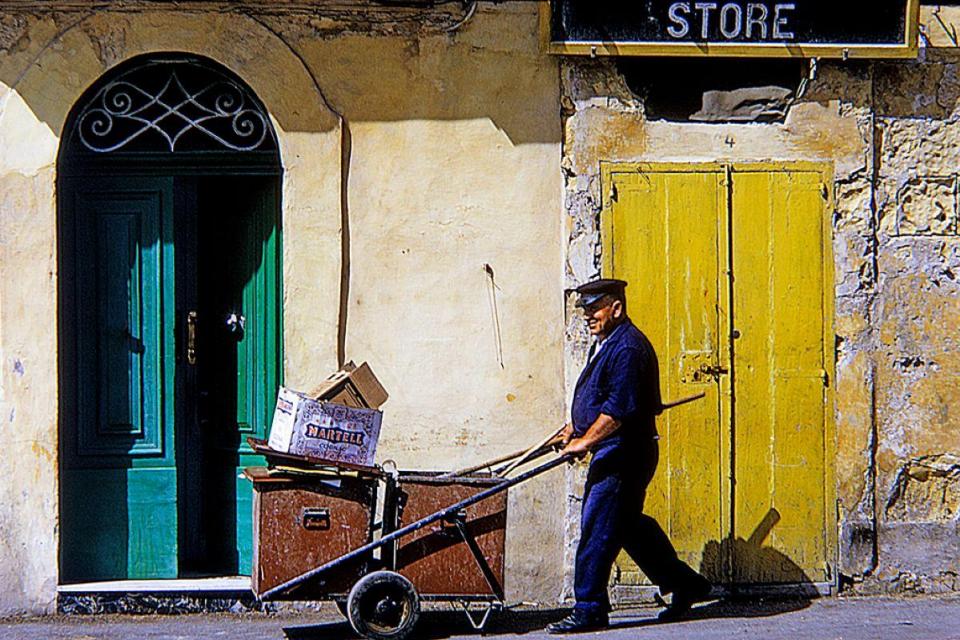Thirteen days in Malta in 1971
Exhibition by Swedish photographer Uno Karlsson documents days past

Malta 1971 and Oskar – photographs by Uno Karlsson is the title of an exhibition currently on at the Malta Postal Museum. Joseph Agius discusses its main theme with Swedish photographer UNO KARLSSON
JA: Colour analogue photography enjoys the property of documenting events that do not belong to a time very long before ours, (at least when considering those among us of a certain age), as its more sombre black-and-white relative does. I was a very young boy when you snapped these photos (six years of age in fact), so they are essentially shots of my childhood, and the sensation of loss is therefore much pronounced, as far as I’m concerned. Their inherent photographic texture stimulates recollection that is very personal. Is this exhibition about documenting loss, your own, this country’s or otherwise?
UK: When I see the pictures now, it is clear to me that I subconsciously documented the loss of my upbringing. But I didn't understand it at the time. Each image now brings warmth and belonging, I have superficially had much the same upbringing as children in rural Malta had in 1971.
I was back in Malta in April 2022 and can understand that there are things missing. But that has always been the case. You remember what you miss and repress what you don't miss.
 Mgarr Harbour
Mgarr HarbourJA: You were a sailor in your youth, enthralled by the vastness of the sea. Was the fact that Malta is an island, governed by the sea in more ways than one, that lured you here in 1971?
UK: The fact that I was a sailor was not the reason we chose Malta. We chose it because it was relatively new as a tourist country. I had read that the Maltese were a very friendly people and that turned out to be true. They spoke English, the island was small. Everything felt so effortless.
 Malta Sunshine in Every Bottle
Malta Sunshine in Every BottleJA: You shot this series in 13 days, meaning that the Maltese commonplace, the everyday and the mundane were utterly photogenic. Twenty-four of these works are going to be exhibited. Would such a photographic project be possible in the Malta of today? Would you still find pockets of old Malta, in maybe the most unlikely of places?
UK: I am convinced that it is possible to take pictures in Malta that will be unique even in 52 years’ time. It only takes the photographer to understand that reality is fantastic enough. That's how I've thought during all the years I've documented my hometown of Strömstad. There is an expression that says: “Dig where you stand.” In Malta, I had the feeling that I understood what I was photographing; however, that can't be entirely true. But I'm proud of the pictures I took in the short time I was there.
My age, 82 years, limits what it takes to hunt and capture images with childlike curiosity and great energy in the right one hundredth of a second.
On my visit last year, I visited New Life Bar and ate ftira which was very good. It is a small bar that also hosts art exhibitions. It felt so personal and the documentary photographer in me came back to life. There are certainly many similar experiences in Malta. But now I leave it to Malta's photographers to depict what in 52 years' time will create thoughts in the minds of the viewers.
 Paceville
PacevilleJA: Which photographers do you find have influenced you throughout the years? Maybe street photographers like Robert Frank, Lee Friedlander, Ernst Haas and Henri Cartier-Bresson?
UK: So many photographers have inspired me. One name that always recurs in my mind is Henri Cartier-Bresson. I have seen two exhibitions with his pictures and it was a great experience. But as I said, there are many. What is a good picture, you do not need to worry about, as time sorts everything out. Imagine how many laughed at artists who died in destitution and now they’re being hailed as among the greatest. A good picture is always a good picture.
 Bellusa, Gozo
Bellusa, GozoJA: Silence, even in photographs that teem with humanity, is a characteristic which I have noticed in this series. The island used to resonate with a rural sobriety, a pastoral quiet. What do you make of its 21st-century messed-up alter ego?
UK: That is a very beautiful description. I also grew up with rural sobriety, a pastoral silence I know what that means. We Swedes are quite few words when there is no big party.
In the case of Malta, I hope that the Maltese will continue to resonate with this. I hope they continue to be the friendly people that I have experienced them to be.
I am frightened by the existence of boundless evil that is completely incomprehensible. But I believe in humanity. There is so much goodness that happens, but it does not get the same space in the news reporting.
 The Shoe Polisher, Valletta
The Shoe Polisher, VallettaJA: Any more comments?
UK: A lot could be written here, but I will make it brief. I photograph people in their own environment, so my studio is big. The people I portrayed have a special place in my heart. This also applies to the pictures I took in Malta in 1971. Sometimes I think about what the children I photographed are doing today. It's indeed a strange feeling.
Malta 1971 and Oskar – photographs by Uno Karlsson is on at the Malta Postal Museum and Arts Hub, Valletta, from May 5 to June 3. A series of black-and-white prints documenting Oskar Nilsson, somewhat of a local character in Stromstad, Sweden, are also being exhibited. Consult the venue’s Facebook page for opening hours.